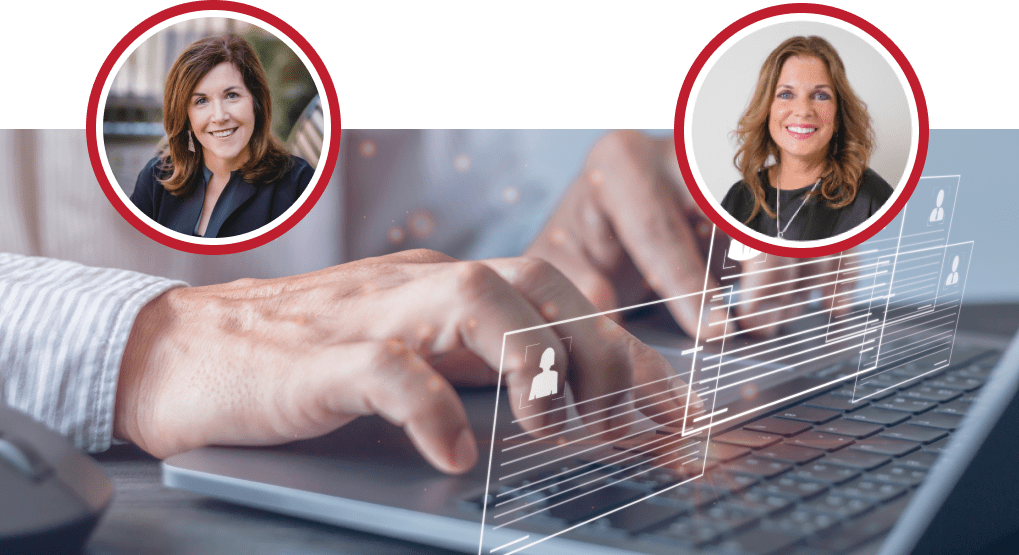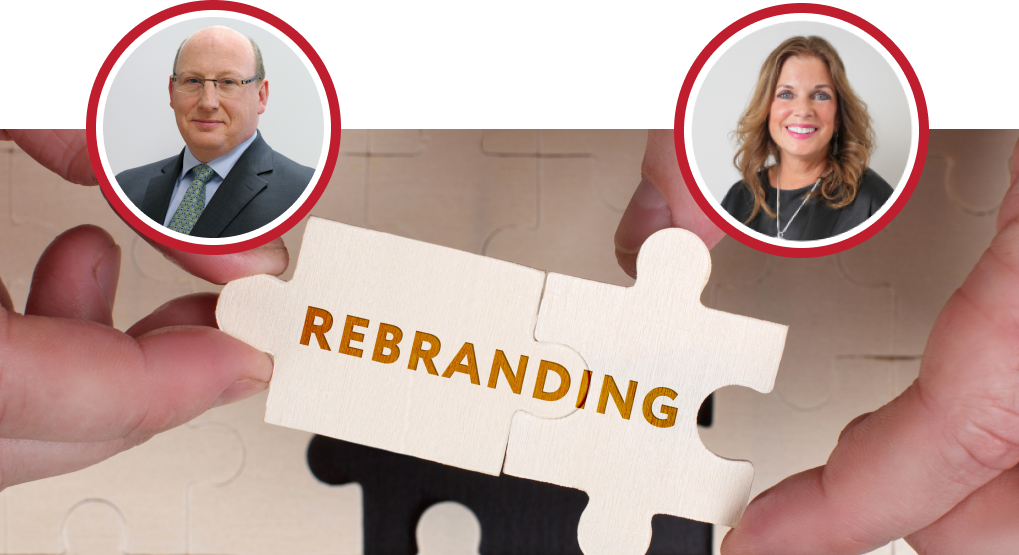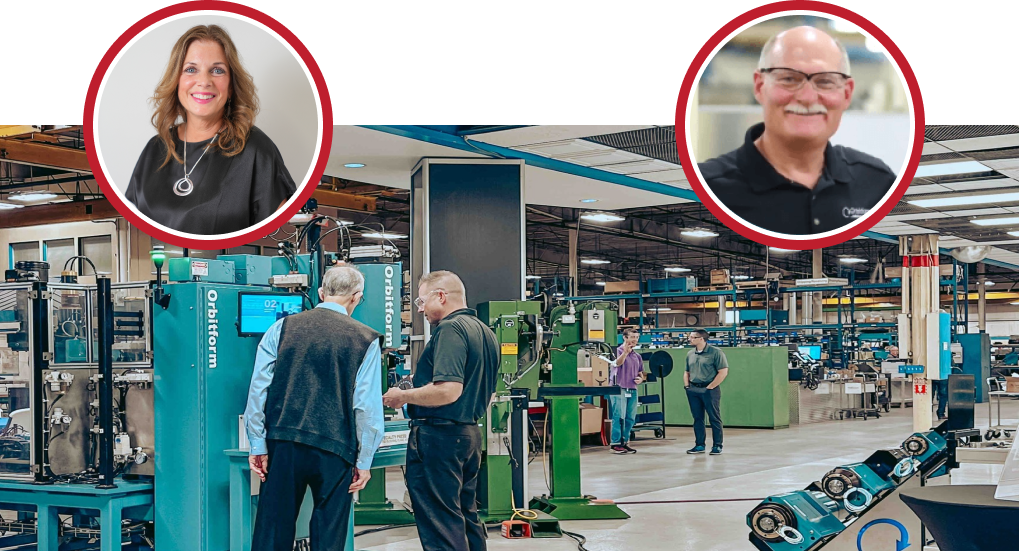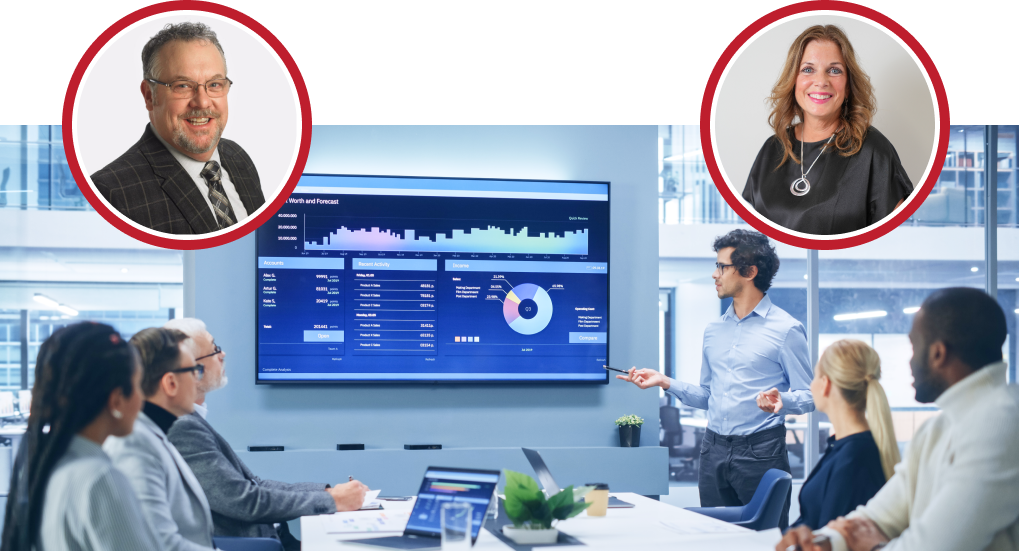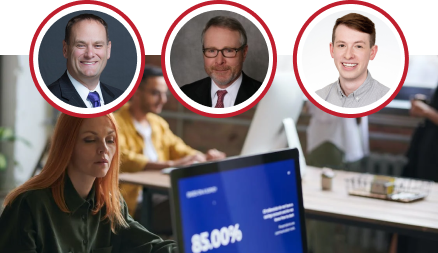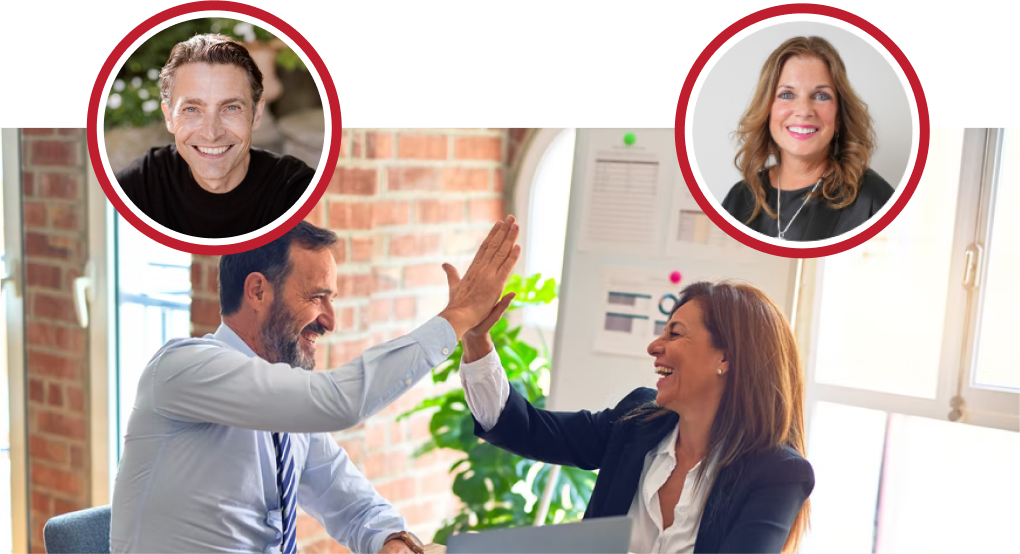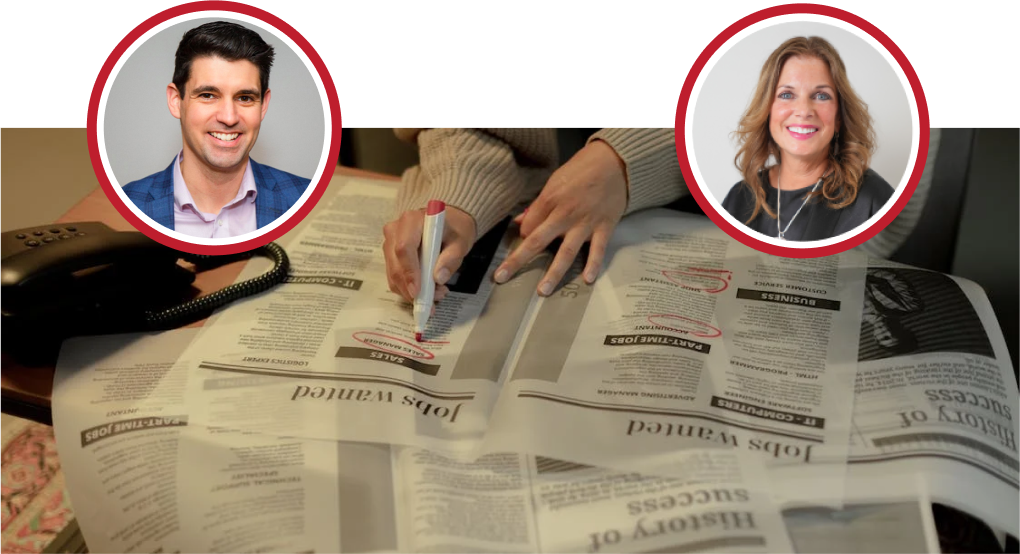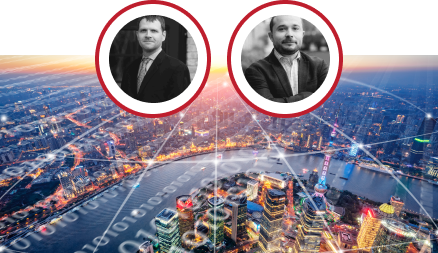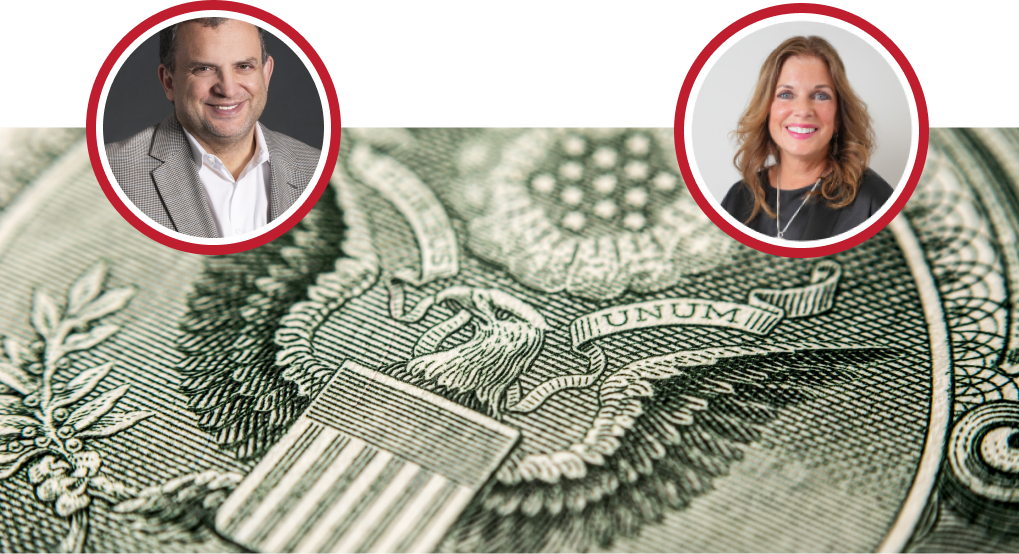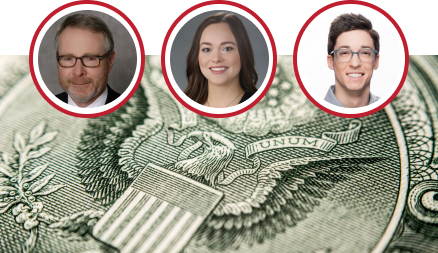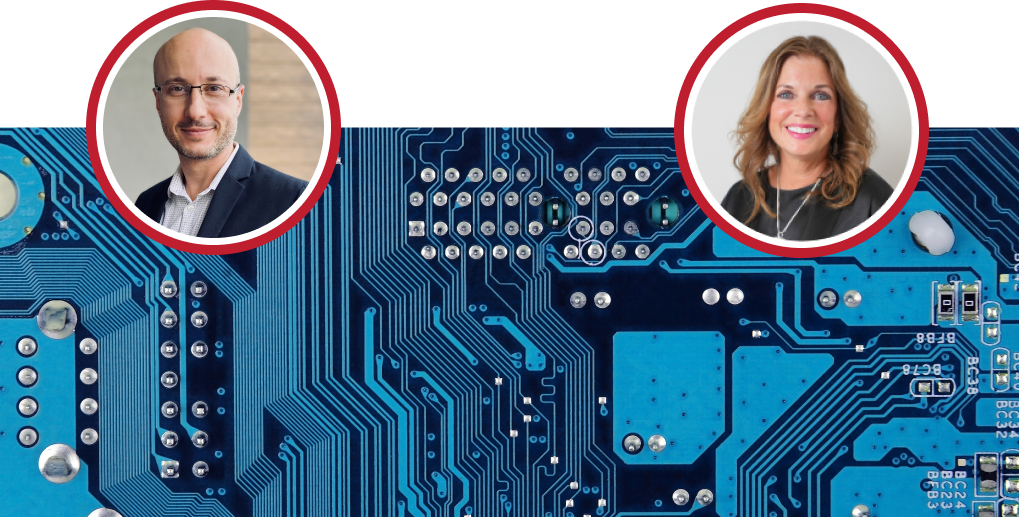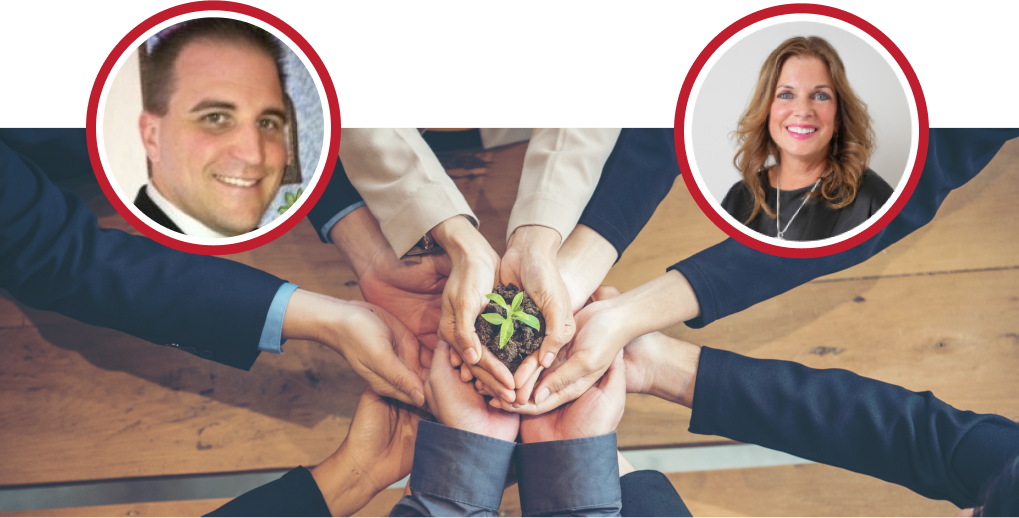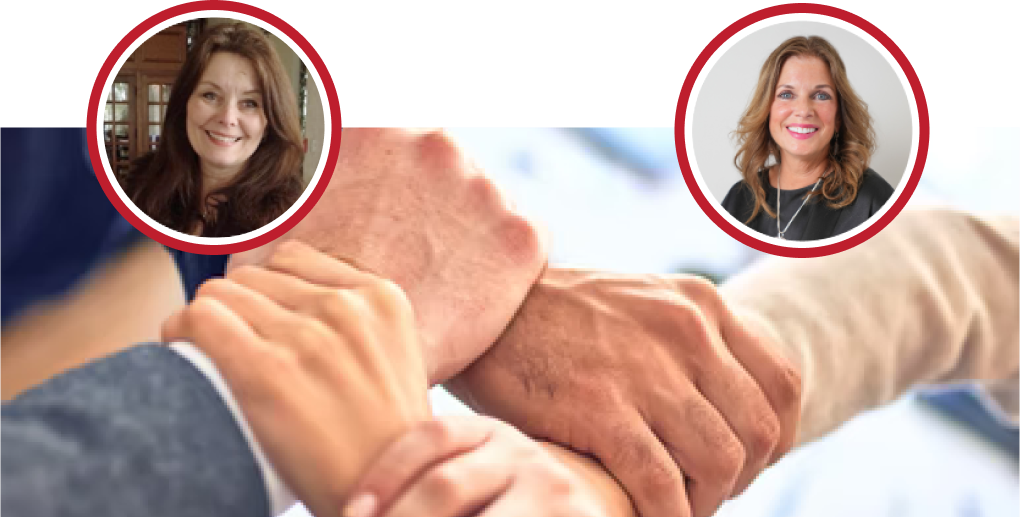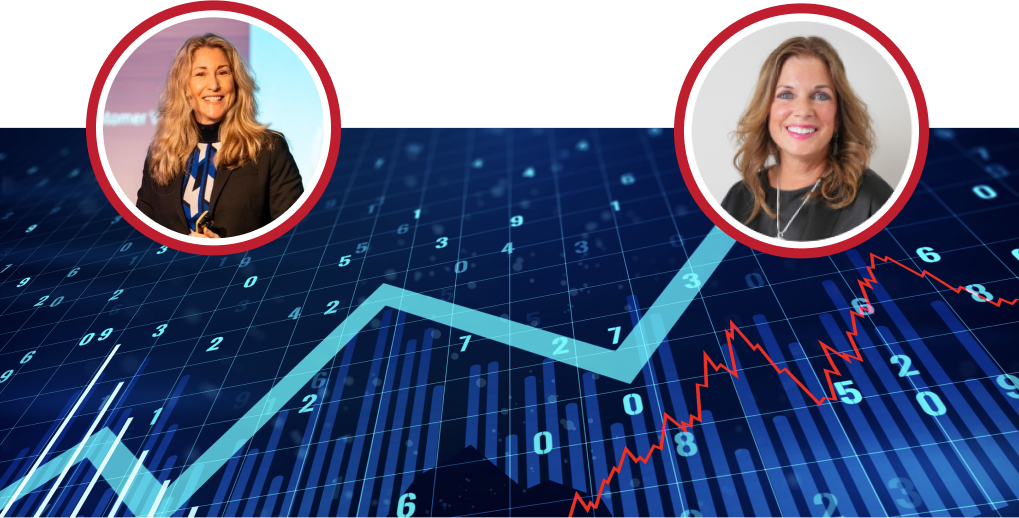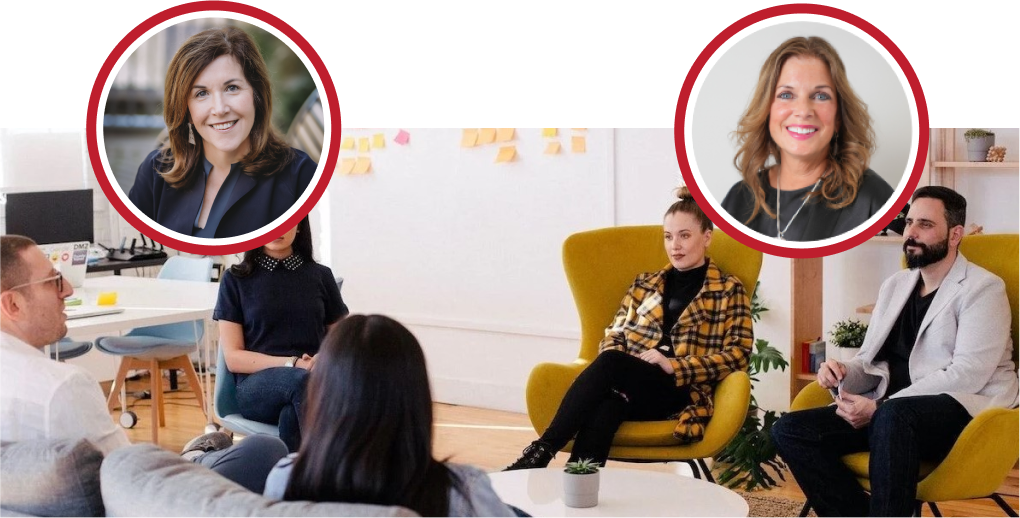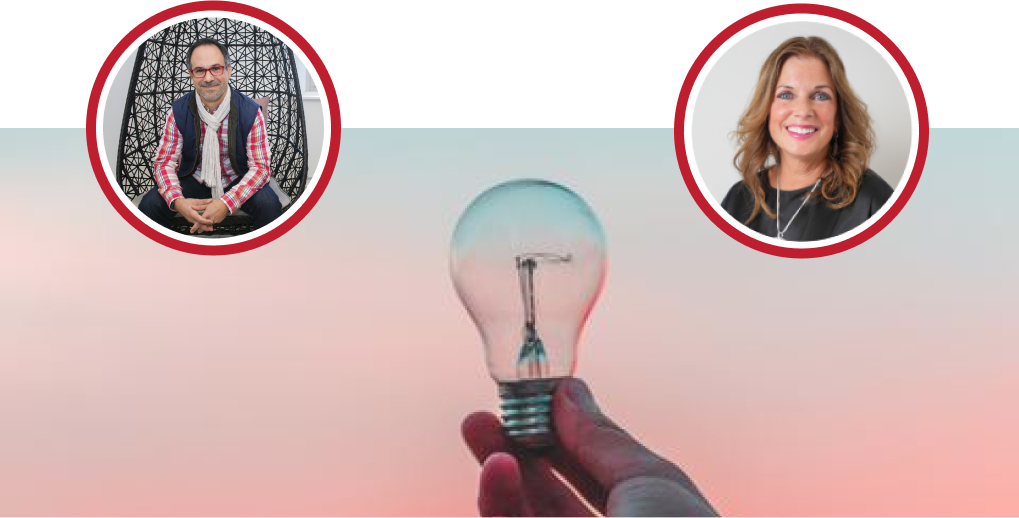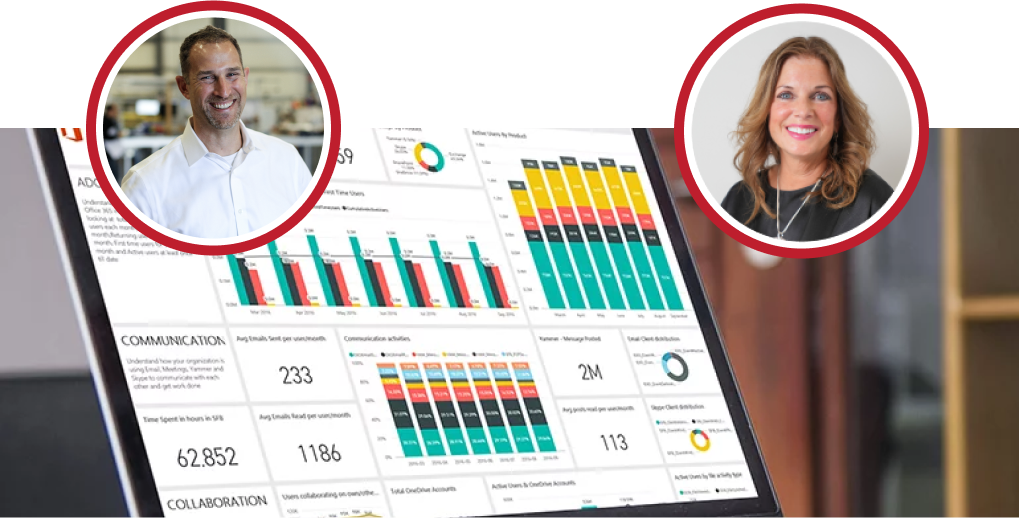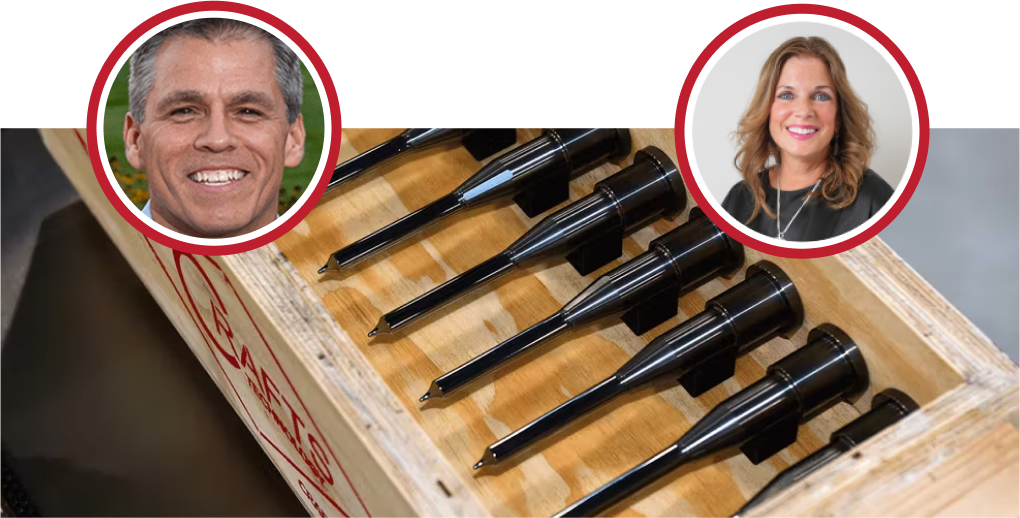Lisa: And thanks for joining today’s webinar. We’ll be getting started in just one moment, so make sure you’ve either got something ready to take notes handy or, in Dean’s case, grab a drink and be ready to hear some great information about how to reboot your business still in 2020. I will give it just one moment great to see everyone, some familiar faces joining today. So, thanks to Tyler, thank you, Ramo, and welcome to Gabrielle Nanette and Sandy. Hopefully, you guys saw your coupons for free lunch which we’ll be talking about here in just a moment. Thanks for joining today, Tom; always glad to see a familiar face on one of our webinars as it is to see Kathy as well; we’ll go ahead and get started. So, again thank you for joining today’s “Business as Unusual” webinar. We are speaking with badass industry leaders who are thriving and surviving in today’s economic climate. My name is Lisa Behning, one of Red Caffeine’s account managers, and I’ll be your moderator for today’s session. We are extremely excited to have the powerful dual powerful duo today of Janet and Dean sharing more information with us about how we can end 2020 just as strong as we originally had hoped when we came into January this year with so many twists and turns in our economic and socio climates it’s wonderful to really focus in on something we can all take control of which is really focusing in on our strategic plan for our businesses and making sure that we can end the year as strong as we possibly hoped just a few housekeeping things today. We do have everyone on mute, so I encourage you to use the chat function or the QA option. Those are both located at the bottom of your screen. I’ll be monitoring those throughout today’s session for any questions that you may have of Janet or Dean. We’ll make sure that they answer those at the end of the session today; as we noted in our email when you signed up for today’s webinar, one of the things that we’re doing is to help support other small businesses, especially restaurants which have been so hard hit during this economic climate is providing free lunch for the first five registrants so as a note we did see their orders come in so thank you from ordering from chick-fil-a and Panera and hopefully, the other three of you will be ordering your lunch this afternoon again in support of all of our businesses across the U.S. that being said I’d like to go ahead and introduce today’s host for our session Kathy Steele, owner, and principal of Red Caffeine so good afternoon Kathy.
Kathy: Good Afternoon, thanks, Lisa, and so want to first start by introducing Janet Viane. Janet, can you just let you be our chief strategy officer at Red Caffeine? But you also wear a couple of additional hats, so could you tell everybody a little bit about you? And then we’ll get them; Dean introduced as well.
Janet: Sure, if you were going after the grandmother had Kathy, I was going to be a little upset about that, but, in addition to that, very proud that I stood on the board of Scott Forge, and I’m also on the advisory board for reviving a company that Dean Chairs and I sit on the board of Gigi’s Playhouse which is a very rapidly growing non-profit in the space of helping those with down syndrome, so I like to make sure that I’m keeping my options wide open in terms of learning you always learn great things from being involved in other organizations, so I’m excited to say in addition to Red Caffeine and badass status there I really do enjoy my outside activities as well.
Kathy: Yeah, thanks, Janet and Dean. We’re so happy to have you on today, and, yeah, good to see you get tired even thinking about the many things that you’re involved in. I thought running a company and being on a board was a lot of coverage myself, so why don’t you tell us a little bit about all the different things that you are navigating and thinking about?
Dean: Sure, it’s good to be here with you badass women. I didn’t know that was a tagline; I like it, doing a lot of things, I, just come from the school of and rather than or a lot of people think about I’m either going to work at a big corporation or, I’m going to maybe work at a startup or a school or something. I just put the word, and in between that and so it’s on a good day it’s good on a bad day it’s it doesn’t leave a lot of time I’m involved in a bunch of companies, two of them are here in Illinois and Rockford where I’m chairman, and one is called PBC linear. PBC is one of the largest manufacturers of linear motion equipment. It essentially is a company that makes a lot of the technology that you never see behind the scenes that makes all the cool stuff that we use work, whether it’s a vending machine or whether it’s a medical machine, or whether it’s the assembly line at Fox Com or Cobos making those work all of those actuators and rails that go in the background that nobody likes to talk about to me that is the technology it’s the part of the technology that makes AI and AR and other things work really well, so that’s one company, the other one is called 3DP was a spin-out of BBC linear where we got them into the large commercial-grade 3D printing equipment, so it’s not something for in your home it’s something very large. They do a lot of cool, a lot of cool things. One of them is working with the Oak Ridge National Labs, one of the United States’ secret treasures down in Tennessee that makes all types of advanced technology, so, down there, we are helping them build one of the largest printers in the world. We can print anything, I’d say the size of anything from a suitcase to a car even to a house, so all types of applications and the next generation there that we’re investing in there’s pretty cool stuff, and the other company that Janet mentioned is reviving, the chairman there, so we’re headquartered out of Helsinki and in Chicago with 1871 and the connectors. Our headquarters down there, so that is a health and beauty and wellness technology AI and AR essentially, you take a selfie of your face as a consumer and it recommends all types of beauty products, cosmetics, sun care products, vitamins you name it. So, that’s bundled with all the top retailers in the world like ultra-beauty and Walgreens down to all the brands that use it as well on their e-commerce sites to promote that, so that’s just some of the commercial stuff involved, and I also teach at Kellogg school. Teach experiential learning program there that’s a lot of fun where we help companies invent new products and actually launch them into the market. We’ve launched products for companies like McDonald’s and United and Whirlpool and others and, also one of the co-founders of 1871; if anyone is listening who hasn’t ever been there, it’s definitely worth the visit to one of the largest incubators in the world down in the merchandise mart, and I’m also an advisor to the NSF (The National Science Foundation), another one of our national treasures that invents all kinds of new cool stuff and yeah I’ve got a podcast that interviews world leaders and business people and CEOs and working on a book that’s, hopefully mostly a lot of the material that I’m writing for Forbes and other, groups too, pull together the thoughts and the platform that we’re doing called dancing with startups so we’ll talk about that a little bit yeah, I could keep talking I’ll shut up now.
Kathy: No, I mean, wow, that so you’re across so many different lines of business, and tell us a little bit about what you’re seeing? How each of these organizations is doing? How everybody’s faring through this recent?
Dean: Sure, I mean the reason I do all that is I grew up in the corporate world and then moved out to Silicon Valley and became a serial CEO. So, I wasn’t really the founder of companies; I would come in and help scale them to the next level, so some of them are family-owned companies like the two in Rockford or family enterprise companies. Some of the largest in Illinois are public companies and private companies, and now doing it in chairman roles it’s I just love scaling companies. So, helping them get from A to B and getting to a successful exit is typically on the agenda. So, covid has provided both opportunities for some and some severe challenges for others. So, for instance, if you take revive, we didn’t really have to pivot much because we were already working on the next generation of technology that says people want to not use the devices in the store, the mirrors and the pads and that all the things you want to touch in the store they want to use this their powerful cell phone to take their own selfies. So, what we’ve seen with reviving is an acceleration of digital adoption by the retailers, and the brands want it faster; they want it to be quicker. I mean, they want to like launch them these are big enterprise accounts so you can’t just launch them overnight so it’s accelerated that company, quite well and we’re getting a lot of interest from just all different types of constituents. So, for instance, there used to just be retailers and brands that would use it. Now it’s e-commerce companies; of course, they were already there, but companies that are some of the largest like a Facebook or a Google or a Tick Tock or a or a Pinterest, all these companies are saying, we need to have a space, we need to be in the beauty space as well, and of course, there’s Amazon and others but also the MLM companies the ones that are selling direct products to consumers. It’s just coming out of the woodwork saying it’s an enabling technology that helps me sell more products. I want to see it, especially if it’s digital and people can use their own phones; if you pivot or shift over to Rockford, if you look at 3DP, there is an acceleration of, everyone is like re-evaluating their supply chain is too dependent on China let’s do this, let’s do that, so, the adoption of commercial-grade again this isn’t in-home units these are big meter by meter and upsize prints that you can print for manufacturing and print for prototyping. We see a, I wouldn’t call it a surge there but increased awareness and an interest in, what’s called Additive Manufacturing and so there’s more interest from companies that we’re constantly talking to us had it on their flow control to buy one or two units now they’re saying what if we bought a hundred and what if we go to with 3DP down to Oakridge Labs and look at this massive printer that they’re building the size of building for six how can we use that technology at a Boeing or a Caterpillar or a John Deere? So that the interest levels accelerating there again longer-term cycles and the last one PBC is, again they’re making all the technology that makes all of this work so with an increase in digital adoption and digital acceleration companies are now trying to figure out how do I automate more of my products and services? So, that’s helpful as a manufacturer. They took a little dip but now it’s coming back, so that’s good supply chain was always an issue when you’re building big things. I will add one thing, though, in terms of an opportunistic project during covid, the CEO of PLC had the vision to say what we could get into there’s a growing space. Just like we got into 3D printing because we were making all the parts, we said, well, let’s get into that same business thing with robotics. He’s making products that make robots work, so it was getting now into the robotics business, and where there’s a gap that we’ve found and partnering them with the NSF (The National Science Foundation) we found that companies are going to put in more and more robotics which is me operating a machine with the robot not just the robot alone in a cage, there is a massive issue in terms of training and educating the next generation of worker just getting them accustomed to using this. So, what BBC is pivoted to is we now have a new division that takes robotics and combines it with AR and VR training that allows them allows any company in the world like a Dewalt tool or a or Boeing or a Ford to accelerate their training programs; in other words, get people certified quicker which is, which is a problem because it just really didn’t scale, so those are kind of three that have pivoted with Kellogg. Obviously, it’s been interesting because everything’s on zoom, or name your platform whatever you like. They happen to use zoom, so moving education to this type of experience has been it’s been a challenge. Education, in some cases its worked, and fortunately, at Kellogg, it’s working pretty well.
Janet: What, Dean, I’d like to add to that because I think one of the aspects that have been happening through this, this pandemic opportunity is the emotional side, yeah, brought up revive and the fact that it’s extremely cool technology at a time when people are not wanting to exchange whether it’s handshake touching things or whatever in a store but they still want to feel good about that purchase, and I think Ravi helps that emotional aspect of the purchase cycle help the consumer feel good right Additive Manufacturing. We at Red Caffeine have had clients who have converted their manufacturing platforms to be able to contribute to helping to resolve this pandemic. Whether it’s making masks or sterilizing masks or whatever it is, they’re feeling good. There’s an emotional side to the way that they’ve been able to adjust their manufacturing platform and contribute to society in a very different way. So, I don’t want to ever lose sight of the emotional side of what’s happening here, too we’ve I’m proud of the clients that we work with and the prospects that we’re in conversation with and what they’re doing to drive a different sense of identification and feeling towards resolving what’s happening out there.
Dean: So, you made me think of an example that I skipped over but maybe at least if you could go back to the 3DP slide, during the pandemic, a lot of companies stepped up around the world, and cosmetics companies started making hand sanitizer, and fabrics companies started making masks. So, with 3DP, what the president decided to do there was be part of the Illinois emergency response groups, and they figured out what it is that you need this is what we need, we need more masks, we need more shields. So, they quickly went into place. If you look at the photo on the right and started printing shields, one of the biggest issues with shields is a head brace that actually is comfortable is flexible that different types of workers can use in a very flexible way, but they essentially need volume quickly because masks weren’t enough, you also needed phase protection eye protection, and quite frankly they still do so they quickly sprung into action again. We have hundreds of massive machines right and started printing, of course, at no cost these units, and then we talked to all the police departments in the Northwest corner of the state and figured out what they needed. So, whether it was just buying the mask or partnering with another company but the shields turned out to be a huge program we made thousands of them and, it was a beneficial it was nice to see a lot of companies in the Chicagoland area kind of coming together working together on conference calls and saying listen we can make the headband you get the plastic and that’s not our that’s not our swim lane and we came together connected devices and got them to people quickly so pretty proud of that you brought up revive though it’s interesting what we have noticed during the pandemics goes back to march there is a massive amount of what do we call it zoom fatigue I hate to plug the name so much but just this type of teleconferencing thing and we were always looking at our faces most of us weren’t used to being on cameras so much unless you were doing a podcast it’s like why would I be looking at a camera all the time it’s exhausting first of all I don’t really like it i’d rather just do audio but we quickly found out through the revive index which measures consumer intent and actually their behavior on the platform on major retailers and brands. We found out that the search algorithms that we saw as skin cosmetics were way down, obviously because people weren’t going out that much. They still want to look good on camera, but the actual skincare went way up to 400 percent of people were concerned about their fatigue, and so it wasn’t just psychological but also physiologically people just wanted to look good on camera probably didn’t see that coming. We saw it coming in the trend data for retailers, but we never thought it would actually be linked. We probably should have ads on zoom like hey, you need to freshen up your face here. Use the use of the review reason revive app and go to ultra-beauty and get some of these products, so that the during the pandemic maybe we’ll talk about this there are two types of companies there are ones that are like recoiling and hiding and trying to figure out how to reopen then there is no reopening it’s all changed now or in those ones that are saying how do I springboard ahead and create a new feature and actually use this as an opportunity to maybe double my market share and that’s those are kind of companies that I like talking to.
Kathy: Well, I mean, that’s a perfect segue to that, that type of a question is it time for everybody? Is it an advantageous time for everybody to reboot or diversify or be opportunistic? Can you talk a little bit about why is now the time to think about this for almost any organization?
Dean: Yeah, I mean, then this is the best time probably in our lifetimes, but I’ll even say my parent’s lifetimes going way back to reboot a company because the old model what you used to do is dead, everything’s dead, any product curbs you had, any forecasts, any data. I stopped showing data that was produced after December because it’s just entertaining. Now it’s not very helpful so, so if I go back to the basics, what one of the things we teach at Kellogg and how I help CEOs of really large companies is, say, what is the problem with big fortune 500 companies? So, if you look on the left we this is usually a builder slide but we call them BFs they’re big they’re fat and they’re slow and when I talk to CEOs of big companies like AmEx or something they say yeah I know tell me something new Dean I’m like well here’s the problem it’s we’re probably not going to change too many of those variables that’s okay you’re a multi-billion dollar company in 130 countries I get it but that connected tissue in between the red stuff irrelevance obscurity and decline that is the that is the trick that is the in a defensive posture you’re trying to stay away from a relevance obscurity and decline of course the, the everyone always makes fun of my Venn Diagrams as a professor but the, the center is always a good thing or a bad thing in this case it’s a bad thing it’s death of the company and that’s why you’ve seen a lot of 500 and fortune 500s go away over the last 50 years and it’s been that curve has been accelerating for a variety of reasons but anyway more importantly how do you fix that whether you’re a small company or a big company this is the funny part even startups have this problem when you get over 50 people you essentially can start getting big fat and slow. So, three ways I go after rebooting companies, whether I was, I’ve been the CEO of over a dozen of them and, or I’m just helping in the chairman roles, we focus on three things people, platform, and passion. So, the people are basically figuring out who’s actually going to help us take this company to the next level people that work in the company, people outside the company partners, all different types of Gigeconomy workers, and even our customers and clients. It involves everything and sounds, so that’s like a that’s like probably an hour-long drill down there the platform is probably we’re talking about most today these are the products and services and new ventures and things that you need to create, creating the future this is where most companies are thinking about rebooting right now, and the last one is patching why is it that people want to work? Or how do we recreate a passion that actually takes this company to the next level? Most companies are not their employees at a large scale and are not really connected to it as much, so the reason you want to reboot now is not so much from a defensive point of view. Many companies have had to do that. Many companies have been forced to go into these rabbit holes and say, what the hell are we going to do now? and the CEOs of these multinationals or mid even mid-market companies listening in they’ve actually jumped down through their directors or VIPs whatever hierarchy they have and have been making day-to-day tactical decisions on things because they’ve had to it’s been triage for four or five months right. So, what has that led to that has led to a lot of senior people in these companies, big and small, diving down into the details going? Why the hell are we doing this thing this way? And the cool part is from an operations point of view, many of these companies have now streamlined their operations eliminated people or eliminated processes, fixed their supply chain, figured out new ways to 3D print stuff versus buying them, figuring out how to pull stuff back from, let’s just call them the high-risk type of countries and they’ve systematically kind of looked through their company and said how do we change things from a customer point of view supply chain costs, cash many CEOs have never had to talk about cash and as many of them now do have to on a regular basis. So, it’s kind of forced people to look at everything from strategy to customers to operations to the cost of cash, so that’s still triaging mode. Your question is more okay, so what are we rebooting towards? So, this is the best time to say in a down market and potentially going into a recessionary feeling market, what should we do to grab more market share to increase our profitability to do all the things that we learned the in the triage mode we’re closer now to our business we know what we want so the smart ones are saying we need to do a lot of build by borrow we need to figure out what new products are we going to build which ones are we going to partner with and buy which ones are we going to acquire there’s more, inquisitive stuff going on about acquisitions right now, especially of small companies. I’m talking about mid-cap companies listening, and they’re saying there’s a bunch of startups that have been nibbling around the edge that are actually probably a good deal right now. So, we’re seeing that activity is going on as well.
Janet: What’s interesting, Dean, is that my team at Red Caffeine knows a couple of weeks ago, in light of all this dynamic environment, I decided to go back and re-read the blue ocean strategy. Remember the classic from 15-plus years ago, right? Yeah, except we’re in a red ocean now, a lot of blood, well, that’s it exactly right. So, I wanted to go back to my old version with all my tabs and my corner pages and everything and re-read the mindset there because so much of what you just cited on this slide and in your comments are so very much aligned to the thinking that was brought out 15 years ago that frankly, I think it’s pulled out every time there’s some kind of recessionary to 1990 in the gulf war, or 2000 in the tech wreck, or 2007 in the real estate debacle. Every single time we run into one of those opportunities, I think people repo their strategy books and say okay, how do I get my way through this? What you talked about with your slide is very much aligned with the reduce, eliminate, raise and create dynamic of a blue ocean strategy. It’s that same thing that makes the best of what’s happening here, and I love the fact that you included a slide like that. This is, I think, a chance for so many of the folks that we speak with to really reboot, not only what they’re doing, how they’re doing, and whom they’re doing it for, redefine complete redefinition mode.
Dean: Yeah the, I just think the old books are you just dust off the old books everything’s changed no matter what you were doing in January it’s changed in many I mean it’s your tagline grow to market how do you grow to market is you have to figure out the market’s over here now guys your business model is toast your strategy is stupid it was good a year ago now it’s not in it, so the rebooting now is like such an everyone’s using the word now. I wish I got a royalty on it every time they did because they realize how systemic it has to be and how deep down into the court has to be, but the good news is they’ve got this management team now who’s been shocked, and they’re not afraid to do it as much, so the big ones are a little more willing but it does go back to strategy the strategy now is like why is our business model working this way? Why are we actually? We’re a product company, should we be in services, should we be partnering with this group, should we be buying these startups, should we, we’re going to we could die here is there’s a lot of the boardroom discussions going on what is our downside protection so a lot of the governance and board discussions that have been going on the last two years in good times have been quite frankly too, they’ve just been too much on the the peripheral it’s like oh this is nice this is good maybe we should do a study on this and diversify and now it’s like no hell no this is about even the board members now digging down and saying why do we do it this way why does our competitor do it this way and how do we kill our competitor there’s a lot of those boardroom discussions going on right now what do you mean kill them well over the next two years there’s an opportunity some someone’s market share is going to double and others is either going to be flat or go down and the smart ones are figuring out how to do that and if you, if you.
Janet: Forget about just killing them; make them irrelevant, right.
Dean: Well, yeah, make them part of the relevance of security and decline yeah, give them keep them with the BFs tag, and I think the last slide I put in if you want to bring that up, kind of goes into some of the tactics of it might be a little bit too much in the weeds but the, I started this program for the purpose of helping BFs’s, it’s called dancing with startups, and we talk about a lot in the podcast, and it’ll be in the new book, but the whole concept is the reason you just dust off the old books is the whole theory of co-creation open innovation, augmented innovation. I like to call it that building growth platforms outside of the company now is important now more than ever of course you need the best people in your company they need to be empowered and unable to do things but you can’t just use your own people anymore and some companies still don’t get this, so they go, yeah, we get to build by borrow by the way if you look at build by borrow the latest survey done by, I think it was envy basically surveyed CEOs saying they all want to do more of this specifically that buy and the borrow but then the next slide showed their survey that said and how are your capabilities inside the company to do more buying and do more partnering than the borough side and it went from like 70 down to 30s and 40s they’re not confident that they have enough for the right people in the company to get this stuff done well I think that’s changed a lot too why many of them have now had to go under the covers into the weeds down to the muck of the company in order to save themselves most of them Perts even look at this big companies united airlines others that have they have had to get tactical they now know more about their company and the people that more than ever and I think that’s great because the first thing is about it’s people platform passion right you’ve got to get the right people going in the right direction. So, my pitch to everyone out there is like I know you think you have the right people working down the hall you need people that don’t work at your company helping you not consultants I’m talking about Gig economy workers, contractors, and startups so that’s what the dancing with startups thing is and if you want I’ll just bore you with the final one which is probably confusing but that’s the one on your right that is the grid that shows well how do I as a manager in a company dance with startups how do I do this kind of next generation innovation so, should I go through that is that all right so the the access is there on the bottom it’s people partners and resources and then the vertical accesses your organization, your location, your culture, so it’s kind of like that’s the way this is broken up just in case you can’t read it and there’s four quadrants you can enable the core people that are there you can bet entrepreneurial ecosystems inside your company you can set up things where you can escape the mothership and then the one up in the top right always the best one right and that’s like a full engagement of the entrepreneurial ecosystem so enabling the core is like what are you doing to enable the employees that you think are the most capable ones to have more latitude to actually be able to innovate to grow the company to let them kind of go out and try things and work with outside companies and so enabling the core , there are so many stories of innovations that were started in one big company never ever went anywhere and then were launched by another big company why because they didn’t enable the core they really the whole fear of failure thing is still an issue guys so sorry about that it’s just it’s not going away yet the second one is embedding entrepreneurs inside companies this is what I used to do when I was a child, I was like the entrepreneur inside companies like an Extern, FedEx and ATT and starting up new ventures and things so actually bringing them into the company and helping allowing them to start new ventures and do new things with your employees that embedding them strategy is becoming more and more popular whether it’s an entrepreneur an actual Gigster economy kind of worker or an actual startup top left would be escape the mothership I’ve done this a few times where we essentially start a new division or a company and we locate it somewhere else physically get out of the building physically escape the culture. So, when we did a cable TV startup, we went to Denver because that’s where all the cable TV companies were at the time; we did another one located in London. So, the physical and another one in silicon valley, so it’s not just physically getting away but it’s allowing a new venture to be created as if you’re doing a startup yourself maybe you use your own people maybe use a mixture of inside outside so we kind of encourage people to dance in all three of these quadrants and then it gets them better at the top one which is how do I like really partner with these companies and start buying them and acquiring them and doing other things so like one example Whirlpool, we were doing all the other three down below we were like dancing with startups they were partnering with hundreds of companies and out of that came a couple acquisitions that they were saying we probably should buy this one we’re like yeah you’re right to be an awesome thing to do so this kind of discipline now this this this is it’s not theory this has been around for like 10 years there’s a lot of companies doing this now but what I’ve noticed jack to your question what has coveted done is there’s an acceleration of this and the acceleration depending on the industry is around how do I how does my company become more digital like I can’t just call Salesforce and Microsoft and SAP, and google, and Amazon and I need other things that are going to be part of my proprietary nature. So, maybe I’m going to acquire a little startup company that has this specific module that it’s going to be proprietary for us. So, if you think of PBC, they’re getting into robotics, and they’re adding virtual reality augmented reality training it’s totally new for them. It’s way out of the box, and they’re doing that with partners, but they’ve decided we actually want to build and own this ourselves, whereas other companies are saying we need to go out and acquire something quickly in this market. So, that’s one way to think about it just in terms of the framework.
Kathy: Yeah, I love it. I mean, I think we’ve been seeing it too kind of take shape. I was at a pitch competition for future founders last fall, and I was really surprised; a couple of years ago, who was looking at these young entrepreneurs and their pitches? Walmart was there, some really big organizations looking for the opportunity to embed an entrepreneurial entity within their organization, and I think it’s super fascinating, and Janet, I think it confirms our go-to-market model or our grow-to-market model for Red Caffeine. So, I love the affirmation from you that we’ve been doing.
Dean: Yeah, I mean, it’s all about growth. I mean, I always throw in the word innovation because they’re; I think one of your questions in our warm-up was, what is innovation? It’s like most companies actually don’t know the answer to that question, and that’s right, it’s dangerous. I will just give you one warning that what is on this slide it’s not a hobby; it’s not something you can have one person do; it involves everyone the corporate dev group, your corporate, venture capital group, your product groups, your marketing groups, it, it involves a full-on assault. If you just have one guy that’s in charge of innovation is, whether or not he’s even in the same division or building or whatever, it’s like this is hard work, and it’s not something you can just hey, we went to a pitch contest, and that was fun that’s like the petting zoo phase it’s like you really have to make it a systemic part of your company and that has accelerated during Covid. People are like, yeah, no kidding, so two things co-creation is accelerated and digital the amount of the level of digital, literacy inside companies something we measure at Kellogg. I teach this is like very low in certain industries. It is off the charts now; the literacy might not be, but the need and the desire and the want for companies like you to come in and help them become more digital, and all my friends are like, we’ve been telling them this for ten years and like all it took was one crisis to drive that forward so, we’re seeing I’ve seen a lot of that happen now.
Janet: Hey Dean, I want to talk about that enable the core piece for a second because a lot of our organization it’s the hardest one by the way well exactly which is why I want to chat about it because a lot of organizations have had the court just to play defense. These months they’ve really had to rely on their core to get them through, oh, I don’t know a 25, stay at home for their manufacturing staff because they were all testing positive right or whatever it may be. It’s been challenging so clearly enable the core to stay alive, enabling the core to innovate and grow that I want to put out what have you seen Dean that really pushes people to take that talented intercourse staff and let them go wild because I agree to let people have at it you can get some incredibly crazy results but easier said than done because as you said it’s one of the hardest and everything that you’ve seen that has succeeded in that space.
Dean: Oh, I’ve seen some things; some of them are embarrassing. Yeah, it depends on the industry, depends on the industry, and the culture that accesses that culture on it, and it’s like it doesn’t always fit, so it really has to fit them to fit the culture, so what works? What doesn’t work, for instance, is enabling the core is just a lot of dressed-up stuff. It’s like we’re going to be big in innovation. We’re going to have an innovation lab, and here’s this new person from outside the company and he’s VP, this is what happened at Whirlpool, this is the VP of innovation and, and then the next phase of that became a more systemic part of that corporation which is good it’s like went back to the division. So, it depends on the culture. For someone like Samsung, you’ll see that they are innovating in and around and all over the company. Someone like a McDonald’s, back when Steve was the CEO, came in and said, listen, innovation is important, but we’re going to call it something else. It was the digital group because I think the most important thing to do is identify what do we need to do? Well, in that case, like we need to be more digital, we need to hire a Chief Digital Officer, and they’ll figure it out, and that became their innovation engine. It was like very, very important and participative, but it was also a focused group, so it was enabling the core, but it was also bringing in a whole new group of people at a very different level of scale and having a Silicon Valley office and all that type of stuff. So, that’s just serious table stakes and usually you find a few people in the company that come along and some outsiders that don’t care about you or your payroll or your benefits they’re just there to make some money but also help you achieve the goals faster the speed at which you can go depends on who you’re deploying on the outside, and you also need people like us that can say listen been to some bad dances seen a lot of bad rodeos here’s the three things you should do three things you shouldn’t do , for smaller companies though that this is called mid-caps, it’s like okay, great, I got two guys, I got harry, I got sally, just a stereotype but here, it’s like can I enable them and my answer is usually like well let me meet them first but yes it just depends what you want to do if you want them to be digital experts overnight no it’s just not going to work they are what I call subject matter experts at this business they are really good they know exactly we had this at 3DP they know exactly what’s going on in the space let me then bring in one other person or not me you add someone from the mix that comes from another industry not another department people will tell you cross-functional this or that’s like no someone actually who can bring you expertise, from another industry to get you into that business. So, startups struggle with this as well, even Ravi, we’ve said listen, leading global there are a lot of countries now, but it’s cosmetics it was skincare, and sun care it’s like okay, we need to get into supplements in health and wellness like great you need to bring in some other experts that are like really good at that so even at a small level if you’ve got under 50 people, enable a couple but enablement is about giving them the tools give them the power if you will letting them fuss around and another word for failure by the way and, understanding what the table stakes are saying this is how much you can spend this is how much you can risk before I’m going to shoot you in the head and maybe get that in writing from your boss. So, what playground you’re playing in, what often happens, and I’m a victim of this when I was a child is you’re the entrepreneur running around the company doing all types of things, and so next thing there’s a new CEO, and they come in, and I go who’s this Dean guy running around spending money building this new business, and they tend to get amnesia sometimes when it’s when things shift and change well that’s going on a lot in code postcode right now, where now the management team is questioning a lot of the products and services that are going on and saying we need to tighten up this strategy and just do this I’ll come in and say, I think you need to do just the opposite you go ahead and do that, but you still need this little skunkworks of projects going on. So, that’s why we do the foursquare grid. It’s like maybe there’s one or two inside with your own people, maybe there’s one with entrepreneurs outside. You definitely need to make a big bet and separate from the mothership and while you’re at it, start partnering and acquiring companies, and you’ll see some companies that coordinate all that. So, like a craft, they have a corporate venture capital group right and a corporate development group they don’t really work together that much; you go over to Models, they pretty much work together a lot. It’s just a different culture; it’s a different strategy, it’s a different way to say let’s because they are two different things, you go to a sales force corporate development corporate venture capital strategy all under one guy it’s beautiful it’s brilliant, but it’s a tech company it’s digital it’s a little cleaner, but it’s, so I tend to find these large companies they have so many projects going on and that’s by design a good thing, but you’re seeing now post-pandemic a more focused structure at the top that says we need to be reviewing all this and it’s nice to do all these experiments but some of them we’ve got to make some big bats. So, I mean the smart ones are saying three years from now, where do we want to be less market share we want more market share, and I tell them like you want to create a new market there are new markets that are being created the products and services never even been invented yet, so, and that’s why I need to dance with startups, I mean there will you can have another speaker on next week that’s going to say Dean’s wrong you don’t need to partner with startups, they’re just a bunch of kids running around with ideas and, I’ll say yeah right, and I didn’t say ignore your people I said you need to bring those two together and then magic happens.
Kathy: I love the idea of partnership. I’ve not seen it always executed extremely well because I think that from a startup company mentality, getting into bed with a large organization, there are some caveats that I think people should be aware of, but what I tend to see most often is people talk about things and how great this co-marketing objective gonna be but it never really takes shape because nobody’s really willing to give up what they want out of the partnership. So, can you just speak a little bit about executing a partnership strategy? And what would be one or two things that need to be discussed or embedded in that?
Dean: Yeah, it’s an often overlooked and very smart question because I have a whole module on this catalog that just after we go through all the how do you do it? Then, it’s like, how do you actually get a contract done that over incense people to keep their eye on the price and what you’ll find in most big companies come in and say, well we need this, this, this, this, this, I get all these things checked off, and I go actually, you really want to give the startup more involvement you want to give them you want to maybe take less equity in their company want to maybe give them more cash you want to over incent them to be a part of the solution. So, they don’t flame out in six months and say we’re going a different direction we want you want it to like overly work well, and so it’s counterintuitive when you actually get to negotiating those two things are important the actual structure I won’t go through that’s very boring it’s a licensing deal or a code deal or 20 ways you can structure a deal and then the incentives and whatever you think you want to give someone unless you’re really generous think about doubling that and what would happen to your speed to market and your market share. So, that what, that’s what doesn’t get measured when you’re negotiating, it’s like, yeah, what’s more important that we give away another five points of equity or that we actually get to market in June and I say June of 20 not 22 guys which was last month I get it yeah I want it I want it last month that’s usually what I tell them right exactly anyway getting into the weeds there but, it’s it is a it is a really rewarding thing to do and just personally I’ll add that one of the things I also teach people and I’ve got this module called finding your purpose it’s related to this it’s like many company people working in large companies like I really like all the stuff you’re saying how can I actually start doing it should I quit my job and go work for a startup or hang out at 1871 and that gets back to how I started it’s like the power of and it’s like no you can actually do it now keep your job start working with a startup volunteer, Red Caffeine would always take free volunteers to help you as a person can play both in the corporate world in the startup world or the academic whatever it is that you want to do it doesn’t matter but you have to you have to kind of buckle up and kind of put a dent in your calendar and say I’m going to do both of these at the same time and that is a very valuable skill if you can go to your boss’s boss and say I know how to operate in a startup and I don’t know how to operate in the corporate world and I like Dean I can kind of be that bridge guy and help you guys. So, when whenever we do the dancing with startups program, we only do this for large corporations typically; we know the CEO it’s, and we always look for the handoff. We’re not there to do it forever. We guide them through it; we do the work for like a year and a half to two years but make sure we’ve groomed or brought someone in who can actually take it over and run it because it’s not going away; it’ll probably be called something else, but it’s not going away as a skill, you cannot sit around and grow your own company by yourselves anymore.
Kathy: Yeah, well, I completely embrace this idea. This isn’t something that we’ve been working on at Red Caffeine as well because we just recognized there’s just no way we’d be able to possess you to know all the skill internally sets that some of our organizations and clients would need, and so I completely agree that this is it’s just a better way to, to do business to just be able to bring best in class and having to get people to level up in areas so quickly where they’re just not going to be able to deliver on that the value. So, we had so many questions. I don’t. Was there anything Janet that we didn’t get to that we wanted?
Janet: No, I think, yeah, we covered a big portion of what we intended to from that perspective, and I want to make sure people get their answers. So, why don’t we go ahead and go to the questions?
Lisa: Sounds perfect. So, the first question is from, let me go back up here from Adam. So, Adam said we are a small company, a restart-up if you will, is how we phrased it; we’re moving from healthcare outpatient into telehealth. So, obviously a very trendy item, right now too, should we expect to enable, embed, escape and engage? Or should we concentrate on some versus others? So, Dean, if you want to start there, what advice would you give to Adam and his team?
Dean: Well, Adam, first of all, congratulations for pivoting. Most people are afraid to, and they get stuck, and then they die company’s gone, so you did the pivot telehealth is good to tell us another one we’ve been talking about for 20 years now people like, oh, we should do telehealth but yeah no, you should. So, you’ve got a great opportunity to accelerate your trajectory because there are already other companies doing it; you could partner with there may be competitors, but check them out, and you can really start partnering with clients right away so, whether it’s doctors or clinics or labs or hospital whatever you don’t the ecosystem, but there are ways to accelerate that, so we typically I mean I love b2b businesses because you can actually go to the customers and say what do you need? How can I make this better? What do you hate about zoom? How can we make your telehealth thing really rock? I’ll give you three things right now that I hate about it, but I won’t, so that’s an accelerant, that’s great, so yeah, good work.
Janet: I think the thing that I would add for Adam is that as we experience working with clients and their growth strategies, they’ll come and say we want to do everything we want to acquire a company, we want to launch a new product we want to expand geographically. We want to gain share from an organic growth perspective. They want to do all of this, and the reality of it is it’s awfully darn hard to enable in-bed escape and engage all at one time and do it all well, so my gut sense Adam is to pick one of those lanes and at least start by being very good at that getting some results out of that before migrating to try to do all four.
Dean: Yeah, your two are simple. You’re just in bed, Adam. You need a couple of experts in this. You guys were not doing too well, so you need one right away; get them in there whether you hire them or use them, and then engage the ecosystem, and that’s everyone. That’s how you, those only two I’d mess with at your size, you don’t need to enable, and you don’t need to separate from the mother ship because you’re not big enough yet.
Lisa: Great, next question comes from Tom, and I laughed when I first read it and thought of a past experience I personally had. The good news is that in many organizations, we have folks who’ve been with us a long time. The bad news is we have many folks who’ve been with us for a long time. Do you have any tips on how to change culture when we’re talking about this entire kind of transformation looking to startup enterprise, Janitor Dean, I’m one of you feel comfortable taking that question first.
Janet: I’ll go first with that one. I find that one of the things, when you look at lessons that larger companies can learn from smaller companies or startups, is that it appears scientifically proven that cultures in smaller organizations are typically stronger than in bigger organizations; when you look at having to shift culture, I think a lot of it depends on what it looks like how old it is? Who’s driving it? Is the leader in charge really driving that culture? And to the extent that you’re going to use culture as a driver in this very effective time, I would work on that very aggressively, and I’d start with the top; no doubt about it, the culture’s got to come from the top.
Dean: So, Tom I don’t know how big the company is but I was going to take a midsize guess here, this isn’t time to screw around anymore this is your perfect time to have a come to Jesus meeting or as many of them as possible including some in person this whole social distancing thing you get the whole company together in a park I don’t care where in the parking lot, and talk to him I don’t know if you’re the top person or whatever but he or she and you and just doesn’t matter even if it’s your own group but it’s to come to sorry about the religious connotation but to come to Jesus thing is still a well-used term when things are not going that well so you’ve got this perfect opportunity to say everything that we used to know has changed forever and here’s the good reasons the good news here’s what we have to do with customers here’s what we’ve got to do with our messed up supply chain or whatever your ten top things are just narrow it down and say these are the three things I care about and at some point you’re gonna figure out who’s on the bus who isn’t on the bus and I’m all for shifting the culture you’ve got to try that first you’ve got to get people reengaged and you also have to look at what, I need to start bringing some new some new blood.
Kathy: Yeah, I mean, I will just only add to is that this is an opportunity, especially with an older generation of an employee base, to have them step up and help, mentor some of the younger like newer employees. I mean, people have just gotten hired, and all of a sudden, they’re working remotely they’ve never even been a part of your culture, so it is we’re in like a unique situation where, we’re faced with things that we’ve never had to be faced with before, and I think there’s an opportunity to leverage people within your organization, to help you rebuild or retool culture as well.
Dean: Reboot that works.
Lisa: We’re going for the royalties to you all right, so our next question comes from Joe says, I work for a startup within a midsize manufacturing company, and innovation has been difficult as there’s a huge gravitational pull from the core business, for example, to follow the core processes the policies the rules financial metrics, etc. it’s definitely hindered our growth and the executives don’t seem to comprehend the value of separation, so question being any advice on how to sell the idea of separating from the mothership.
Dean: So, it depends on what your personality is? If you’re in a really prissy mood you just should just leave one day and go set up shop somewhere else just say listen, I’ve got a new location it’s whatever 1871 Chicago it doesn’t cost that much 500 bucks, unless you have like 20 people we have to talk but it’s like at some point you have to stop and you have to shock them into it I don’t know how high up you are but if you’re the if it’s your group doesn’t matter go to the gut whoever’s running the group go to her and say listen we need to separate from the mothership what the hell does that mean it’s like it means what it means it’s brutal it’s not easy to do however, here’s some examples of other companies that have done it both big and small it’s funny it’s probably not a great example but Exelon has always had this corporate innovation group inside and I always would take them to 1871 just as a good civic person no agenda and we’d do a dancing with startup session and eventually they got fed up one day and they said what I am I’m moving my whole group out of this corporate building it is awful in the in the bank tower there in downtown Chicago. So, their whole innovation group now had their own area in 1871, and it just helped them immensely; they’re closer to the ecosystem people from the company want to come over now the diversity of thought is incredible, and they’re able to partner with people just like that around the world not just in Chicago but it’s tough I mean you’ve got to have, some one-on-one discussions about the value and the benefit but the worst part is not maybe not leaving, but I’m just reading your question now it’s like all these rules and regulations and financial controls and all the crap that large companies have to measure is very important for them it is also startup killers it’s not what you, it’s not how you measure startup it’s about momentum, and growth and share or you’re dead, so it’s like come up with this list of a list say listen here’s what we’re gonna do if we do any of these things you can kill us but leave us alone if we’re doing this just start with that little list.
Janet: That’s what I’ve just said. I think quantifying the value of the innovation is going to get the attention if you can demonstrate some level of return or some level of repositioning in a market, something that will get your C-suite’s attention to say, oh, okay, time-out, maybe I should be listening more intently or taking you up on your ideas more aggressively if you can drive the quantification of the value, I think, it’s huge.
Dean: Yeah, what the issue there is it’s just two things its basic control and trust; they want to control you through the processes and financial reporting that they’re used to have; it’s just it’s actually laziness and trust like, oh this is that you must fill this out I’m like oh I’m sorry I don’t know how and but trust, so you’ve got to if they don’t trust eventually, they’ll that’ll work itself out bad good or bad that’s gonna work itself.
Janet: Outright, I would agree there’s not much you can do there. I was just trying to help Joe keep his job. You’re just way too kind; you can’t sugarcoat this stuff; give him hell, give him hell, Joe [Laughter].
Lisa: All right, and final question as we wrap up today’s session. So, of course, as we look back on the first six months of the year, it’s definitely been, I would say, an overall kind of negative blip if we’re going to look back in the year 2040 and look at 2020 and go wow, what happened Janet and Dean? What would you say is kind of the silver lining coming out of 2020? So far that you feel going to impact the next 20 years of business.
Janet: Silver lining, honestly for me, I think there’s been a very different level of collaboration that has come out of organizations being forced to work in a different way, and collaboration being a pretty big lesson that I think startups and smaller companies are better at than larger organizations. I think it’s phenomenal the way we have witnessed and spoken with organizations who have had to work differently and have totally raised their level of collaboration in the process. I’d like to see that say that gets stuff done.
Dean: It’s good, I would say two major impacts when you look back 10, 20, 30, 40 years from now I was like this is the end of the industrial revolution because it was still going on everyone said it wasn’t like oh we’re in the fourth I’m like no we’re not , it’s the end of that it has totally changed and the second one is the final adoption of technology that’s been here since the 50s we’ve had all this technology now it’s going to get deployed in a very strategic very smart way and all of these companies that were like have all these plans and thoughts and all the stuff they’re looking at they’re now saying how do we do this faster like oh well I’ll show you, it’s just there’s a lot of just overthinking going on about deploying technology so the technology companies love that when I say that so like I mentioned them all before all the big cats right but it’s also going to drive a next generation of technology investment and venturing so those of you that are looking to startup companies there’s never going to be a better time it’s hard to see that right now in the depths of what the hell are we doing we can’t go back to the office and that is why the industrial revolution is ending one of those the way it’s coming out there’s probably 20 a list of 20 but one of the biggest one is like the the old adage of having to get up in the morning do my thing get in the car get in the train go to the office that whole office culture thing has been blown up and is shifting most people are saying yeah it’s just temporary it’s all going to go back to normal actually even if everything works out fine and everyone gets healthy and life gets better by 2022 , it’s not it’s not going to go back it doesn’t have to go back what we have been telling people for years like telemedicine is you don’t need it I will show you , ads and things from 1980 that show some of the first , teleconferencing some of the first pc based , zoom calls it’s just it’s taken this long and it took a crisis to accelerate so I do not see that going back and you look at companies like a Microsoft and even a sales force the amount of contact they’ve had with customers now is off the charts and they’re learning how to do it remotely. So, B2B already is a major benefactor to consumers and retail a little bit tougher people still want to go out and touch the stuff, but that’s one component of 20 of how the industrial revolution is shifting, and for those of you that ask these great questions like your startups, you need to think a little broader right now it’s like I know we were doing telemedicine but what about this and that too it’s like yeah make it bigger make it better, so I think there’s a lot of silver linings. Unfortunately, a lot of people have died, and it’s a sad time still.
Lisa: Great, well, thank you, and thank you, Janet, for participating today. Thank you to our audience for your wonderful questions; for those of you that might want to get in touch with Janet or Dean after the webinar, perhaps you will think of a question later. We do have their contact information on the screen, so you can go ahead and look them up on LinkedIn, or you can also send them an email just reference unusual in the subject line so they know you’re coming in from our webinar today so again thank you to Janet and Dean for being our featured guest today.
Dean: You’re welcome. Good to see you all.
Lisa: Great. Well, continuing on in our “Business as Unusual” series, we do have our next webinar on Thursday, July 16th, featuring Josh Bronson, the Director of Business Development and Marketing for Elk Grove Village. So, when you think about everything that’s happened in 2020, so are Janet and Dean saying rebooting your business. Imagine if you were the go-to person for over 3 800 businesses looking for that level of support. So Josh is part of the largest U.S. industrial park, and so for them, they’ve really been focusing on helping all of their businesses thrive during this economic climate. So, stay tuned next week when Josh is going to be talking more about some of the things he’s picked up during the last six months, such as building the value of your database and retooling your existing marketing. So, as Dean just mentioned, your strategy is dead, so how are you going to move forward with that and also pick up a couple of key factors from the public sector that you can actually apply to your own business so registration is available right now at Red Caffeine’s website you can go to the “Business as Unusual” section and register, and we’ll also be sending out a link in our follow-up email with today’s recording as well as some of the top takeaways from Janet and Dean’s information that they’ve shared this is your first time tuning into “Business as Unusual.” I hope you enjoyed it. We do run these series roughly every two weeks. So, stay tuned to Red Caffeine’s website or our social media channels, where you’ll hear all about the next session. If you do have a question for us, feel free to reach out to us at connect redcaffeine.com. So, thanks so much, and I hope everyone enjoys the rest of your day.












